Key takeaways:
- Community engagement focuses on fostering relationships, trust, and collaboration rather than merely gathering feedback.
- Child safeguarding is essential for creating secure environments that enable children to thrive and encourages community involvement.
- Effective community involvement strategies include ongoing dialogue, involving children in discussions, and training members to recognize safeguarding issues.
- Future interactions can enhance inclusivity by combining technology with in-person engagement, allowing more voices to be heard in community discussions.
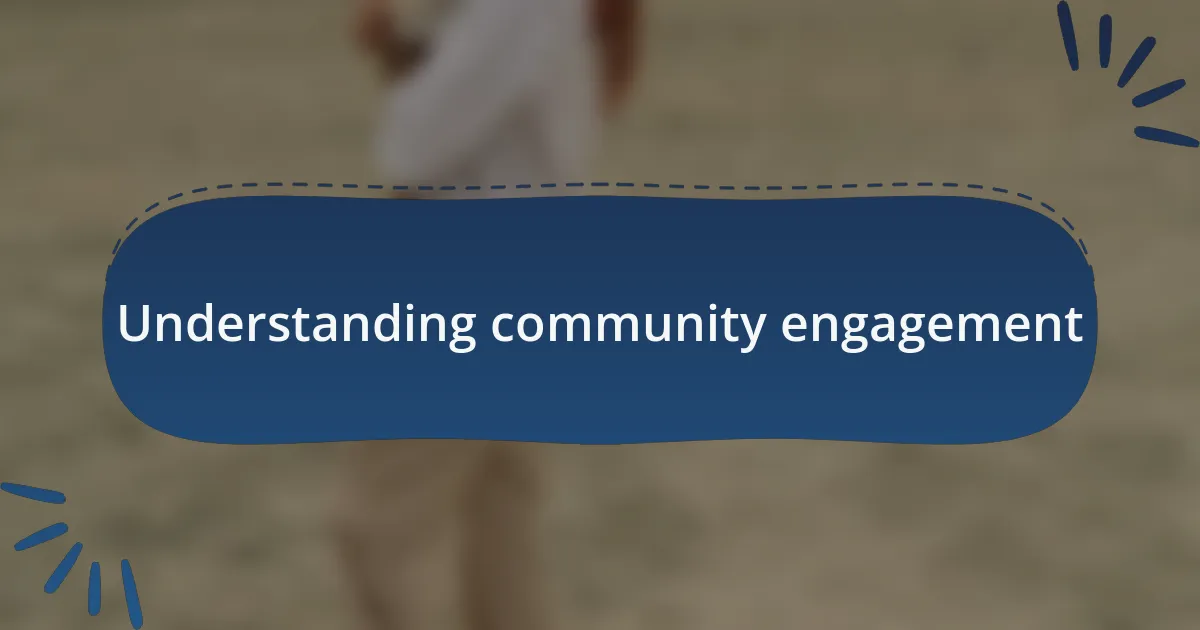
Understanding community engagement
Community engagement is about more than just gathering feedback; it’s about fostering relationships. I remember attending a local community meeting where parents shared their experiences and concerns boldly. It struck me how powerful this dialogue was—each voice added depth to the conversation, revealing insights I hadn’t considered before.
When I think about engagement, I often wonder: what makes a community truly connected? In my experience, it’s listening actively and showing genuine empathy. I’ve witnessed initiatives flourish when local leaders prioritized transparency and inclusivity, creating spaces where everyone felt valued and heard.
Understanding community engagement means realizing that it isn’t a one-time effort. It’s a continuous journey of building trust and collaboration. I often think about how small steps, like regular check-ins or informal gatherings, can make a substantial difference in developing a sense of belonging among community members. The emotional impact of these connections cannot be overstated—it cultivates a safety net where everyone looks out for one another, especially our children.
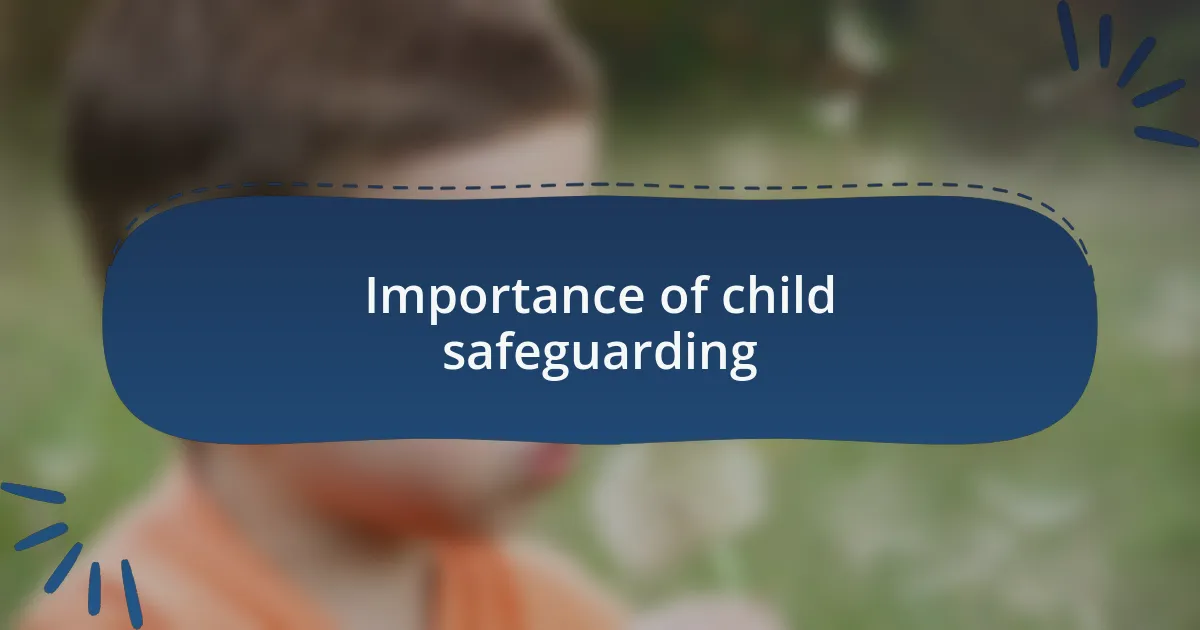
Importance of child safeguarding
Child safeguarding is paramount because it lays the foundation for creating secure environments where children can thrive. Reflecting on my volunteering days at a local after-school program, I saw firsthand how crucial it was for the staff to be trained in recognizing signs of distress or abuse. This training wasn’t just a checkbox; it empowered them to act decisively, ensuring that every child felt safe and supported while pursuing their interests.
Moreover, safeguarding measures don’t just protect children; they build trust within the community. I remember a particular instance when a parent shared their gratitude after we implemented a new policy to address safety concerns. Their relief highlighted a vital truth: when families see proactive steps toward safeguarding, they become more involved and invested in communal activities. Isn’t it remarkable how prioritizing safety can enhance overall engagement and connection?
Lastly, I often contemplate the long-term implications of neglecting child safeguarding. If we fail to protect our children today, what kind of future are we shaping? Every incident of overlooked safeguarding can have ripples throughout a community, affecting not just individuals but families and relationships. This awareness compels us to make vigilant safeguarding a priority, ensuring that every child’s potential is nurtured in a secure environment.
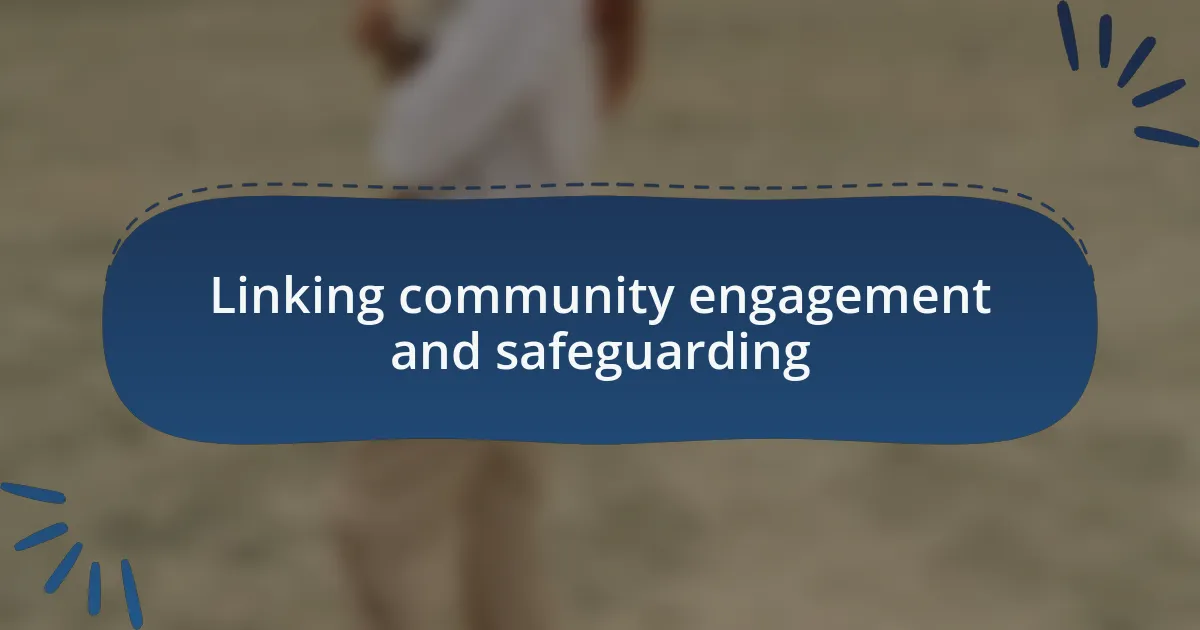
Linking community engagement and safeguarding
When communities actively engage in child safeguarding, the collaboration between parents, educators, and local organizations flourishes. I recall attending a community forum where we collectively developed strategies to ensure children’s safety. This dialogue not only fostered transparency but also led to enhanced vigilance and support systems that resonated with everyone involved. Have you ever experienced that sense of unity when a community comes together for a common cause?
Engagement gives voice to often-overlooked concerns, driving initiatives that prioritize children’s wellbeing. I remember a time when a neighbor shared observations about kids’ behaviors that seemed concerning. Because of our established trust through community gatherings, we addressed those issues promptly, channeling our collective observations into actionable steps. This proactive approach reinforces the idea that safeguarding is a shared responsibility, requiring active participation from every member.
Moreover, my experiences show that when community engagement is robust, children feel the effects deeply. At one local event, I witnessed children interact with safety leaders, their eyes widening with the idea that their voices matter. This interaction not only empowered those children but also inspired their parents to engage more actively in safety discussions. Isn’t it amazing how the influence of secure environments extends beyond mere protection, ultimately shaping children’s confidence and community ties?
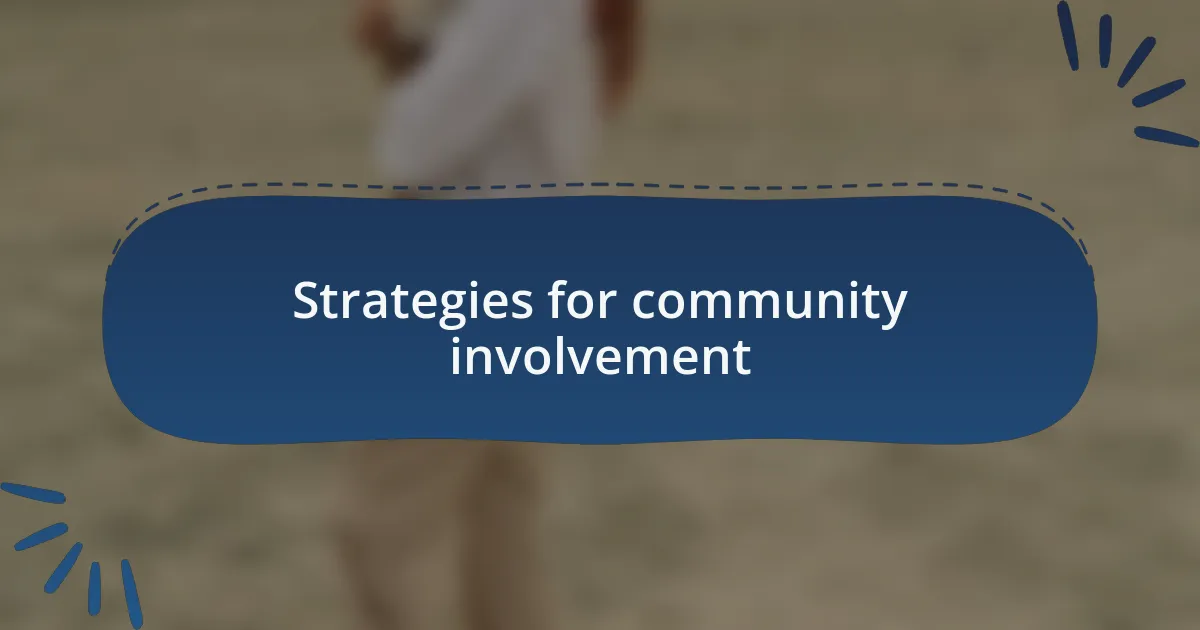
Strategies for community involvement
One effective strategy for community involvement is to create spaces for ongoing dialogue. I remember when our neighborhood organized monthly meetings specifically focused on child safety. These gatherings not only provided updates on local safety initiatives but also encouraged participants to share their thoughts and concerns. How powerful is it when people feel heard and understood? It ignites a shared commitment to action.
Additionally, involving children in the conversation can lead to incredibly insightful outcomes. I once facilitated a workshop where kids expressed their views on safety through drawings and storytelling. Their creativity revealed needs and concerns we hadn’t even considered as adults. Have you ever realized how much wisdom children can impart when given the chance to express themselves?
Training community members to recognize and address safeguarding issues is another crucial strategy. I recall attending a workshop on spotting signs of distress in children. This experience equipped me and others with practical tools to respond proactively when we witnessed troubling situations. Doesn’t it feel reassuring to know that, as informed community members, we can play a vital role in the safety of every child around us?
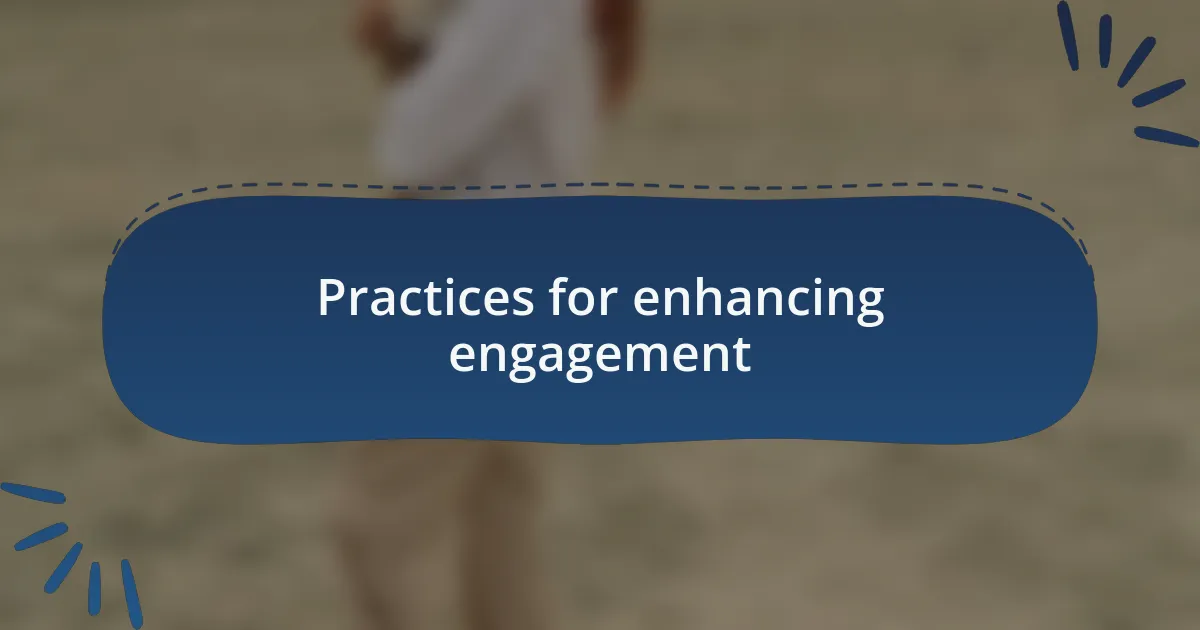
Practices for enhancing engagement
Creating a welcoming atmosphere for community forums can significantly enhance engagement. I once participated in a festival where various local organizations set up booths to discuss child safeguarding initiatives. The vibrant environment encouraged people to stop by, ask questions, and share experiences. Can you imagine the ripple effect this kind of open interaction can have?
Using technology to facilitate communication is another practice that can greatly improve participation. I remember when our local group launched a social media platform dedicated to weekly discussions about child safety. It was amazing to witness how many parents joined in, sharing tips and resources, all from the comfort of their homes. Have you seen how digital spaces can bridge gaps and foster a sense of belonging?
Lastly, fostering partnerships with schools and youth organizations often amplifies engagement efforts. In my experience, collaborating with a nearby school for a safety awareness day brought in not only students but parents and teachers as well. The collaboration transformed our initiatives into community-wide events rather than isolated efforts. Doesn’t it make sense that when we unite various stakeholders, our impact grows exponentially?
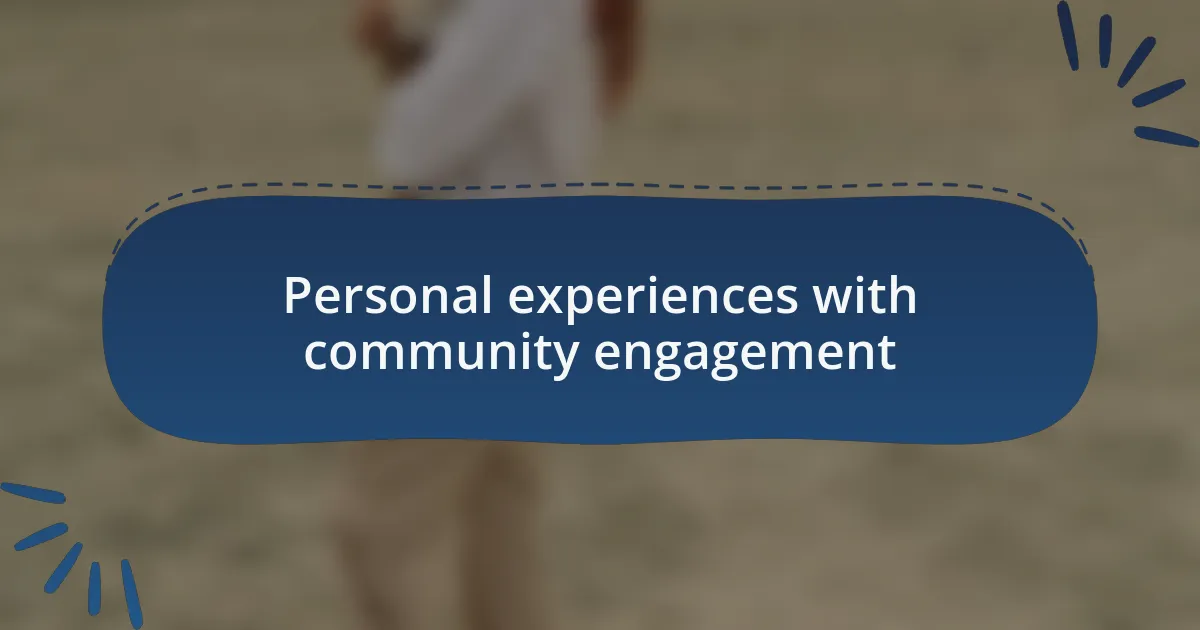
Personal experiences with community engagement
One of my most impactful experiences with community engagement happened during a neighborhood cleanup event. As we worked side by side, I noticed how transforming a physical space sparked conversations about our children’s safety in that very environment. It struck me how our shared goals and effort brought us together, making our concerns feel lighter and more manageable. Have you ever felt that sense of community while working for a common cause?
Engaging with families at local schools has also been a profound experience. I recall attending a parent-teacher meeting where we held a discussion about child safeguarding resources. I could see the apprehension on some faces; parents were eager yet hesitant to share their concerns. The moment someone voiced a worry, it broke the ice. It reminded me that even the smallest act of sharing can empower others. Isn’t it incredible how vulnerability can create such powerful connections?
Another noteworthy experience was during a town hall meeting focusing on youth programs. I was amazed by how the room filled with diverse voices, each sharing their story and needs. It drove home the message that when everyone has an opportunity to speak, our collective understanding deepens. In that moment, I realized that true engagement comes from valuing every single perspective. How often do we really listen to understand, rather than just to respond?
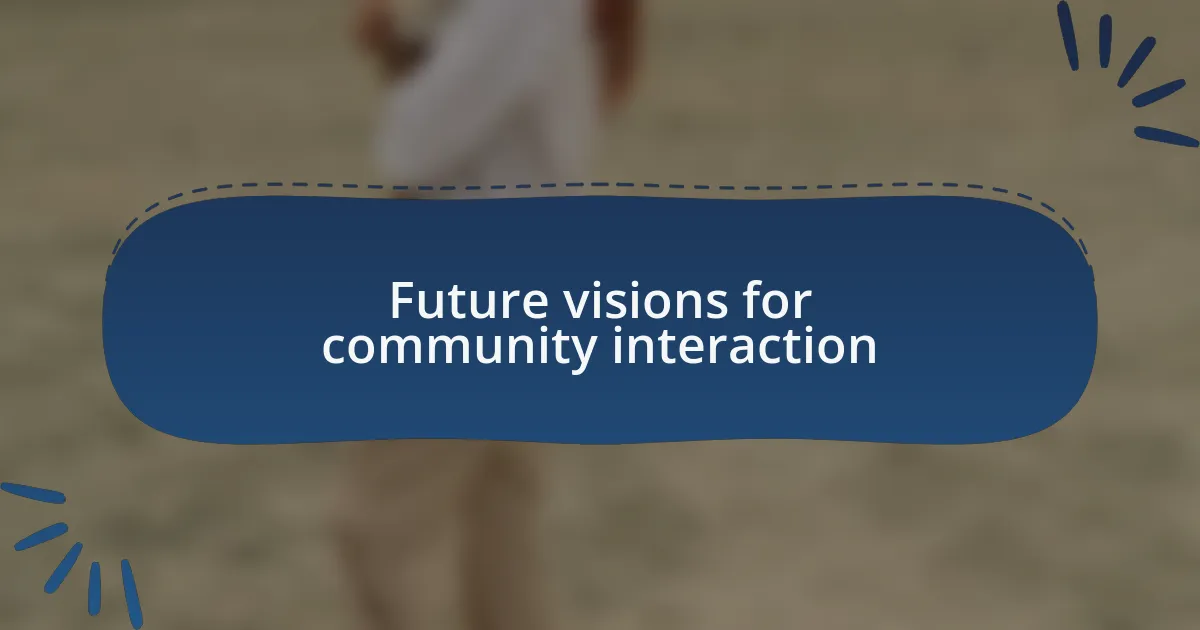
Future visions for community interaction
Imagining the future of community interaction, I envision spaces where technology and face-to-face engagement blend seamlessly. For instance, what if community meetings were not only held in person but also streamed online? This could mean that parents in remote areas or those unable to attend physically still have a voice, creating a richer tapestry of perspectives and fostering inclusivity.
I often ponder how we can leverage social media platforms to enhance community discussions around child safeguarding. Could we create dedicated groups where parents share experiences and resources? This type of digital interaction might diminish the isolation many feel and encourage broader participation, transforming our static connections into dynamic dialogues.
Looking ahead, I see immense potential in partnerships between local organizations and families. Imagine workshops focused on building skills for child safeguarding, led by professionals but designed with input from parents. How empowering would it be for community members to co-create programs that reflect their unique needs and experiences? This approach not only fosters trust but also cultivates a sense of ownership and responsibility among all stakeholders.